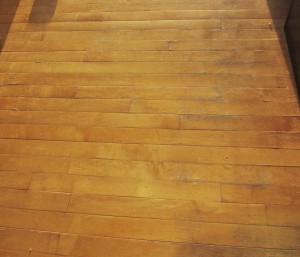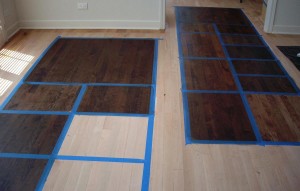Hardwood Floor Refinishing
No matter how careful you and your family, there will come a time when your hardwood floor will need to be refinished. In the best circumstances it might be ten years or more after the new wood flooring was installed. Under heavy use, a wood floor might need refinishing within four or five years. Because we live in Chicago, with winter sand and salt, the intervals between refinishing tends to be less.
How Can I Tell if My Hardwood Floor Needs to be Refinished?
 There are some obvious ways to tell if it’s time to speak with a wood flooring expert to discuss possible refinishing. First, a dull finish is usually a tell-tale sign that the protective coating is deteriorating. Second, either lighter or darker dull patches are fairly good indicators that the top coat has worn off and that you’re down to the wood.
There are some obvious ways to tell if it’s time to speak with a wood flooring expert to discuss possible refinishing. First, a dull finish is usually a tell-tale sign that the protective coating is deteriorating. Second, either lighter or darker dull patches are fairly good indicators that the top coat has worn off and that you’re down to the wood.
Another way to test if your polyurethane finish is worn out is to put a small teaspoon of water in an area you want to test. If the water beads, the finish is likely intact. If the water is absorbed slowly, the finish either has imperfections or is thin enough to allow water to pass through to the wood. If the water doesn’t bead or pool and is quickly absorbed, it is time to refinish your hardwood floor.
Screen Buffing & Recoating
Typically reserved for floors that are still in good shape, this process is intended for a floor whose topcoat is largely intact with only a few minor wear spots. Done properly, screen buffing can save you time and money while restoring the finish to its original beauty.
Unlike sanding right down to the wood, machine buffing with an abrasive screen roughs-up the intact top layer of polyurethane creating a surface for the new protective coats to properly adhere to the surface to promote adhesion.
Once the surface has been properly prepared, a new coat of polyurethane is applied to the surface.
Traditional Hardwood Floor Refinishing
In the traditional method of wood floor refinishing, the floor is put through a series of sanding steps. A belt sander is passed over the wood flooring three to four times until the old urethane and imperfections in the wood are removed. The sander is fit first with a coarse-grit abrasive to quickly remove the topcoat and imperfections. With each subsequent pass, the grit becomes finer leaving the wood very smooth and ready for sealing and, if desired, staining. It is important to close the pores of the wood correctly so that it is hard, durable and water resistant. At Mr. Floor we go one step further than most Chicago flooring companies by screen buffing the floor after each coat of polyurethane. This time-consuming but critical step not only insures that any imperfections are removed, but also that the polyurethane coats are locked together, insuring a better-looking, longer-lasting finish.
Changing the Color of a Hardwood Floor
 If you’re going to invest in a traditional refinish of your wood floor, you may want to consider changing the color. Because the sanding process has completely removed the old finish and taken the wood back to its original hue, you can choose to apply a stain changing, for example, a light oak floor to a dark one. While staining the floor does add an extra step and a bit more expense, it can dramatically alter the appearance of a room, and if you were looking for a change, this is the time. We will apply color swatch samples directly to the floor for you to see all the possibilities and make a decision with no ambiguity.
If you’re going to invest in a traditional refinish of your wood floor, you may want to consider changing the color. Because the sanding process has completely removed the old finish and taken the wood back to its original hue, you can choose to apply a stain changing, for example, a light oak floor to a dark one. While staining the floor does add an extra step and a bit more expense, it can dramatically alter the appearance of a room, and if you were looking for a change, this is the time. We will apply color swatch samples directly to the floor for you to see all the possibilities and make a decision with no ambiguity.
What is the Best Finish for my Hardwood Floors?
Once the floor has been sanded to perfection, sealed and possibly stained, it’s time to apply a protective finish to the floor. (Read about hardwood floor finishing here.) Ninety percent of hardwood floors are finished with Polyurethane.The coats of polyurethane protect the floor and create either a satin, semi-gloss or high shine. Here’s where a flooring installer’s preference can have a big impact on the appearance, durability and eco-friendliness of your floor.
Polyurethane finishes come in many varieties. Water-based and oil-based are typically used, although there are still very toxic acid-cured coatings still being used. Mr. Floor has spent years researching and providing our clients with the best options.
Water-based polyurethanes dry quicker, have less odor and can be more difficult for your flooring contractor to apply. They feature a clear finish that lets the natural color or stain shine through. They’re also more expensive, but the faster drying times, lower VOC emissions and eco-friendliness can offset the additional cost of the product.
Oil-based and acid-cured polyurethanes are less eco-friendly, emitting volatile organic compounds, (that chemical smell). These can also take 10 to 20 hours to dry, depending on the temperature and humidity in the home. Because they contain more solids, the compounds that actually protect your floor and don’t evaporate, there’s often one less coat to apply. These products have an amber tint that continues to oxidize over time and can, in some cases, really change the way the floors look.
Mr. Floor uses water-based polyurethane exclusively, as explained in this article, Sanding and Finishing a Wood Floor. Your best bet is to work with your flooring professional to choose the right polyurethane finish.
We understand that there are many Chicago hardwood floor refinishing companies. Our hope is that this blog post convinces you to call or contact us for a free quotation.
